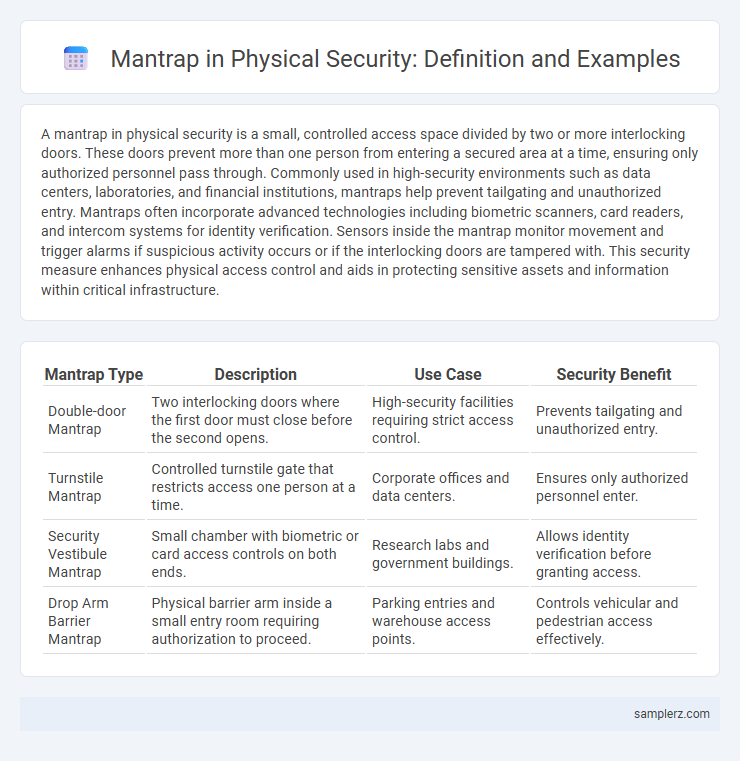A mantrap in physical security is a small, controlled access space divided by two or more interlocking doors. These doors prevent more than one person from entering a secured area at a time, ensuring only authorized personnel pass through. Commonly used in high-security environments such as data centers, laboratories, and financial institutions, mantraps help prevent tailgating and unauthorized entry. Mantraps often incorporate advanced technologies including biometric scanners, card readers, and intercom systems for identity verification. Sensors inside the mantrap monitor movement and trigger alarms if suspicious activity occurs or if the interlocking doors are tampered with. This security measure enhances physical access control and aids in protecting sensitive assets and information within critical infrastructure.
Table of Comparison
| Mantrap Type | Description | Use Case | Security Benefit |
|---|---|---|---|
| Double-door Mantrap | Two interlocking doors where the first door must close before the second opens. | High-security facilities requiring strict access control. | Prevents tailgating and unauthorized entry. |
| Turnstile Mantrap | Controlled turnstile gate that restricts access one person at a time. | Corporate offices and data centers. | Ensures only authorized personnel enter. |
| Security Vestibule Mantrap | Small chamber with biometric or card access controls on both ends. | Research labs and government buildings. | Allows identity verification before granting access. |
| Drop Arm Barrier Mantrap | Physical barrier arm inside a small entry room requiring authorization to proceed. | Parking entries and warehouse access points. | Controls vehicular and pedestrian access effectively. |
What is a Mantrap in Physical Security?
A mantrap in physical security is a controlled entry system consisting of a small, enclosed space with two interlocking doors designed to allow only one person to enter at a time. This security feature prevents tailgating and unauthorized access by requiring individuals to be verified before gaining entry to secure areas. Mantraps are commonly used in high-security facilities such as data centers, laboratories, and government buildings to enhance access control and mitigate security breaches.
Key Components of Mantrap Systems
Mantrap systems in physical security feature two primary components: interlocking doors and authentication mechanisms. Interlocking doors ensure only one door opens at a time, preventing tailgating or unauthorized access. Authentication methods include biometric scanners, keycards, or PIN pads, which verify identities before granting entry.
How Mantraps Enhance Access Control
Mantraps enhance access control by creating controlled entry zones that require authentication at multiple points, preventing tailgating and unauthorized access. These physical security barriers typically consist of a small enclosed space with two interlocking doors, where the first door must close before the second unlocks, ensuring only one person passes at a time. By integrating biometric scanners or keycard readers within mantraps, facilities significantly reduce the risk of security breaches and improve monitoring of sensitive areas.
Real-World Examples of Mantrap Installations
Mantraps are commonly installed in high-security facilities such as data centers and government buildings to control access and prevent tailgating. For example, the U.S. Department of Defense employs mantrap entry systems combining biometric scanners and turnstiles to verify identities and restrict unauthorized access. Similarly, financial institutions use mantraps with integrated card readers and metal detectors to enhance security and ensure only one person enters at a time, minimizing the risk of security breaches.
Types of Mantraps Used in High-Security Environments
Types of mantraps used in high-security environments include interlocking door systems, which ensure only one door opens at a time, and biometric mantraps that integrate fingerprint or iris scanners for identity verification. Another common type is the turnstile mantrap, designed to control pedestrian flow while preventing unauthorized access. These systems are often combined with card readers and alarm sensors to enhance physical access control.
Mantrap Implementation in Data Centers
Mantrap implementation in data centers involves a two-door entry system where individuals must pass through a secure vestibule before accessing sensitive server rooms, effectively preventing tailgating and unauthorized entry. Biometric scanners and RFID card readers are commonly integrated to verify identity within the mantrap, ensuring only authorized personnel gain entry. This security measure significantly mitigates risks such as physical breaches, data theft, and insider threats in high-value information environments.
Airports and Mantraps: Securing Critical Zones
Airports deploy mantraps as critical security measures to control access between public and restricted areas, preventing unauthorized entry into secure zones like boarding gates and baggage handling areas. These physical barriers use biometric verification, card readers, and interlocking doors to ensure only authorized personnel transit through sensitive checkpoints. Mantraps significantly reduce tailgating risks and enhance overall airport security by tightly regulating movement within critical operational zones.
Financial Institutions Using Mantraps for Safety
Financial institutions implement mantraps to enhance physical security by controlling access to sensitive areas such as vaults and server rooms. These mantraps use dual-door systems with biometric authentication and alarm triggers to prevent tailgating and unauthorized entry. The integration of mantraps reduces the risk of insider threats and strengthens compliance with regulatory security standards.
Integration of Biometrics in Mantrap Security
Integration of biometrics in mantrap security enhances access control by using fingerprint or iris recognition to verify identity before granting entry. This biometric authentication reduces the risk of unauthorized access and tailgating by ensuring only registered individuals can pass through the secured entry point. Combining biometrics with electronic locks and surveillance systems creates a multi-layered security solution critical for protecting high-value assets and sensitive environments.
Best Practices for Designing Effective Mantraps
Effective mantrap design in physical security involves integrating biometric authentication systems, such as fingerprint or iris scanners, to ensure only authorized personnel gain access. Incorporating anti-tailgating sensors and reinforced steel doors enhances security by preventing unauthorized entry and forced breaches. Optimal spacing and emergency override controls further improve safety and operational efficiency within secure facilities.

example of mantrap in physical security Infographic
 samplerz.com
samplerz.com